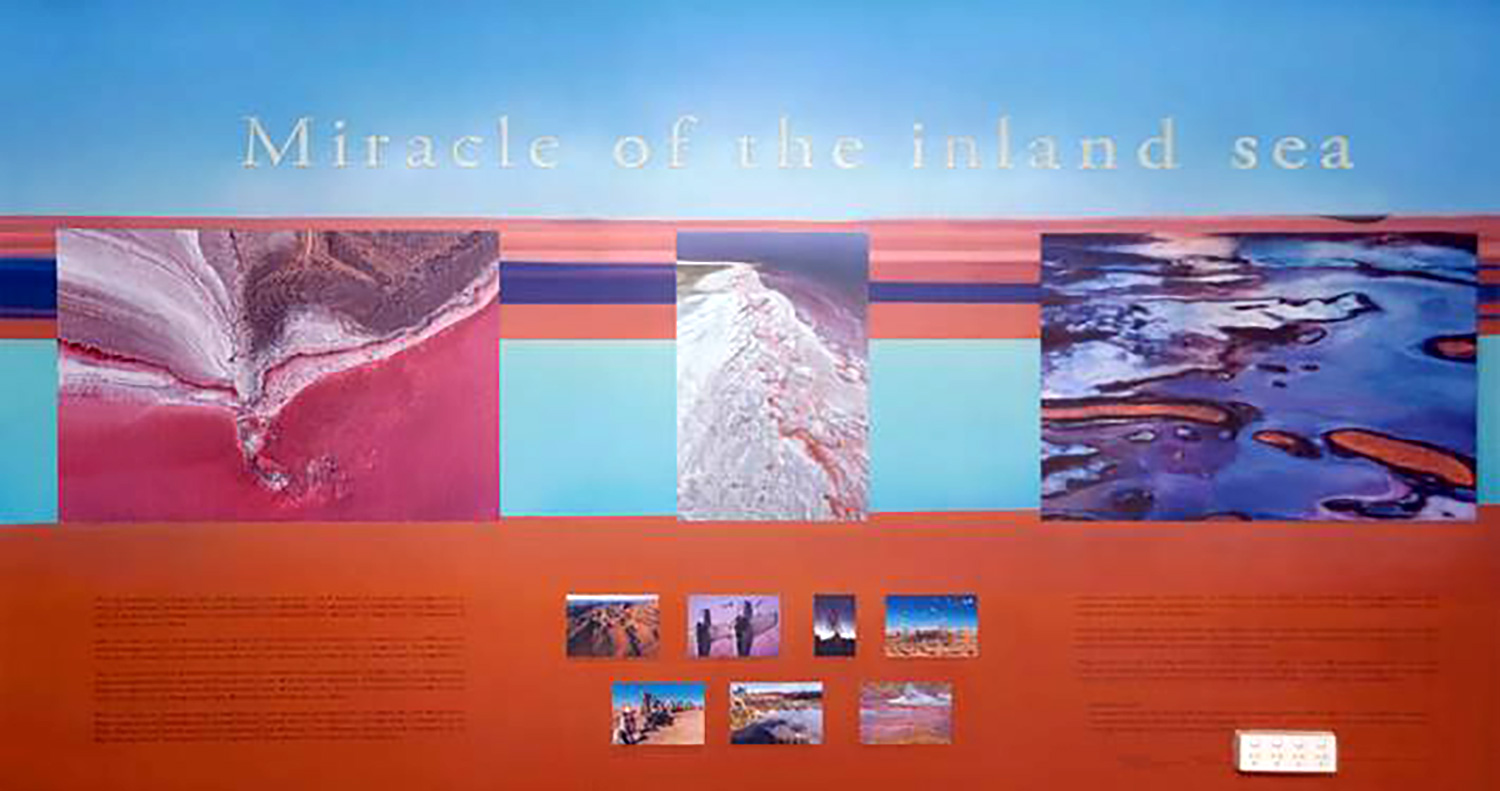
The Lake Eyre Room
Award winning photographer, Peter Elfes, was commissioned to capture a series of images of Kati Thanda-Lake Eyre for a stunning wall mural in the west dining room.
Peter is a regular visitor to the Lake and the Hotel. He and his assistants spent over a week flying the Lake at all hours of the day. He took thousands of images and together, with the graphic arts team, commenced the editing process. It took a further six months to narrow down the final group for selection. The images were then subjected to high resolution scanning and digital plotting on latest technology printers (Screenmakers, Canberra) onto a specially imported, non-reflective film and laminate to achieve maximum effectiveness for the mural. What adorns the walls today is testimony to the professionalism of Peter’s camera work and the long list of technical expertise to create this stunning vista.
The room is a splendid panorama of Peter’s work with plenty of information about the Lake with a cultural perspective from its creation to the present day.
There is no cost to visit. Come and enjoy the experience and look around the heritage listed hotel at the same time.
Kati Thanda-Lake Eyre is the lowest geographical point in Australia, at 15.2m below sea level and, on the rare occasions that the Lake fills, it becomes the largest lake in Australia and 18th largest in the world covering 9,500km² (3,668 sq miles). Covering an area 144km long and 77km wide, Kati Thanda-Lake Eyre is an extensive salt sink which derives its mineralisation from the evaporation of floodwaters over thousands of years. Water from its three-state catchment area covers the Lake about once every eight years. The lake has only filled to capacity three times in the last 150 years.
Marree is the gateway to the vast Kati Thanda-Lake Eyre Basin and is some 700km (435 miles) north of Adelaide. The Lake is named after Edward John Eyre who was the first European to sight it in 1840. The traditional owners of the lake, the Arabana*, call it Kati Thanda.
Kati Thanda-Lake Eyre has been a site for various land speed record attempts on its salt flats, especially those by Donald Campbell with the Bluebird-Proteus in the mid 1960s. Legends have been born from the sheer power of nature that makes the region susceptible to flood and extreme heat – people like the Birdsville Mailman Tom Kruse who battled the harsh conditions on his regular mail run from Marree to Birdsville in the immediate post-war years. The contribution made by the ‘Afghan’ cameleers who consolidated the stock routes of the Oodnadatta and Birdsville Tracks, with their camel trains travelling hundreds of kilometers into the Northern Territory and Queensland from Marree. Many of their descendants still live in the historic town. The cattlemen and women of the region are respected as some of the finest cattle breeders and stockmen in the country. Sydney Kidman stayed at the Marree Hotel and the world’s largest cattle station, Anna Creek, still bears the Kidman name.
History abounds in the remnants of the “Great Northern Development” which commenced as an initiative in the early 1880s with the telegraph line and railroad being the vision for the future. The railway men and telegraph linesmen battled the harshness of the desert environment for 100 years before the railway, affectionately known as “The Ghan”, was decommissioned. Today, the people of Marree (population 75) are the cornerstone of the spirit of the region. The town is fiercely protective of its heritage… and rightfully so. The legacy of modern-day pioneers together with the culture and traditions of the first settlers lives on and presents a warm and inviting presence in this classic outback friendly town.
The traditional owners are maintaining their strong cultural links with the Lake and these, too, are a major point of interest for visitors. On 22 May 2012, the Federal Court of Australia was convened to grant the Arabana people native title to more than 68,000km2 in South Australia’s north, including Lake Eyre (Kati-Thanda) and the pastoral lease of Finniss Spring Station.
Kati Thanda-Lake Eyre is fringed by the Tirari Desert which has been home to the Dieri people for thousands of years. The name for the Tirari Desert comes from the Australian anthropologist Norman Tindale, who in 1939 reported a small tribe which he referred to as the Tirari. They were located at the eastern shore of Lake Eyre from Muloorina north to Warburton River; east to Killalapaninna. On a modest concrete plinth outside the South Australian Museum is a stone object of great interest and antiquity a tree, so say the Dieri people of the lower Cooper, that once held up the sky. On 10 May 2012 the Commonwealth government formally recognised the Dieri Native Title Claim for self determination.
Kati Thanda-Lake Eyre is surrounded by the deserts of central Australia. The Lake Eyre Basin is a endorheic system surrounding the lakebed, the lowest part of which is filled with the characteristic salt pan caused by the seasonal expansion and subsequent evaporation of the trapped waters. Even in the dry season there is usually some water remaining in Kati Thanda, normally collecting in a number of smaller sub-lakes within its margins. During the rainy season the rivers from the north-east part of the Lake Eyre Basin (in outback – southwest and central – Queensland) flow towards the Lake through the channel country. The amount of water from the monsoons determines whether water will reach the Lake and if it does, how deep the lake will be. The -15m below sea level altitude usually attributed to Lake Eyre refers to the deepest parts of the lake floor – in Belt Bay and the Madigan Gulf. The shoreline lies at 9m below sea level.
The Kati Thanda-Lake Eyre Basin is a drainage basin that covers just under one-sixth of all of Australia, it is the largest endorheic basin in Australia and amongst the largest in the world. Covering about 1,200,000km2, including much of inland Queensland, large portions of South Australia, the Northern Territory and a part of western New South Wales. The Lake Eyre Basin is one of four sub-basins of the larger Great Artesian Basin.
Kati Thanda-Lake Eyre is the “miracle” of inland Australia, not just because of its natural characteristics but because the Lake is “alive” with its constant changes reflected in an explosion of colour throughout the year. As the water levels change, so too does the spectrum of colours – it resembles a giant Chameleon, which attracts an ever increasing number of visitors, who are awed by the spectacle.
The Lake has been identified by Bird Life International as an important bird area because, when flooded, it supports major breeding events of the Banded Stilts and Australian Pelican, as well as over 1% of the world’s populations of Red-necked Avocets, Sharp- tailed Sandpiper, Red-necked Stints, Silver Gulls and Caspian Terns, as a result of this the surrounding desert is also home to a large variety of raptors like the Wedge-tailed Eagle, Whistling Kite, Kestrels and many others.
Award winning photographers, like Peter Elfes, are drawn to the region annually and some suggest that the Lake and the whole Basin area is a sleeping giant on the list of natural wonders in Australia and is rising in significance to rival the Great Barrier Reef, Kakadu and South West Tasmania.
But this is ‘remote’ Australia and access to the region is both a challenge and an adventure. So if you are driving out to the Lake, please respect the traditional owners, keep to marked roads, ensure your vehicle is roadworthy, you have an adequate amount of water and that you have notified people of your travel plans and destinations.
When you base your stay at the Marree Hotel, you will need at least 3 nights so you can take a scenic flight over the Lake and surrounding landscape which opens up some of Australia’s last remaining spectacular scenic wonders. The Hotel can also organise cultural tours and has access to a variety of remote tours to private stations – guided, tag-along and self-drive.
About this mural
The concept for the “Lake Eyre Room” at the Marree Hotel was the initiative of past publicans. (2012). With the assistance of one of Australia’s most acclaimed “Lake Eyre” photographers, Peter Elfes, these walls have come to life.
